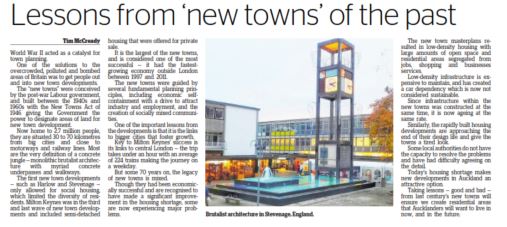http://bit.ly/2Q4FlvI
World War II acted as a catalyst for town planning.
One of the solutions to the overcrowded, polluted and bombed areas of Britain was to get people out and into new town developments.
The “new towns” were conceived by the post-war Labour government, and built between the 1940s and 1960s with the New Towns Act of 1946 giving the Government the power to designate areas of land for new town development.
Now home to 2.7 million people, they are situated 30 to 70 kilometres from big cities and close to motorways and railway lines. Most are the very definition of a concrete jungle — monolithic brutalist architecture with myriad concrete underpasses and walkways.
The first new town developments — such as Harlow and Stevenage — only allowed for social housing, which limited the diversity of residents. Milton Keynes was in the third and last wave of new town developments and included semi-detached housing that was offered for private sale.
It is the largest of the new towns, and is considered one of the most successful — it had the fastest-growing economy outside London between 1997 and 2011.
The new towns were guided by several fundamental planning principles, including economic self-containment with a drive to attract industry and employment, and the creation of socially mixed communities.
One of the important lessons from the developments is the links to bigger cities that foster growth.
Key to Milton Keynes’ success is its links to central London — the trip takes under an hour with an average of 224 trains making the journey on a weekday.
But some 70 years on, the legacy of new towns is mixed.
Though they had been economically successful and are recognised to have made a significant improvement in the housing shortage, some are now experiencing major problems.
The new town master plans resulted in low-density housing with large amounts of open space and residential areas segregated from jobs, shopping and businesses services.
Low-density infrastructure is expensive to maintain, and has created a car dependency which is now not considered sustainable.
Since infrastructure within the new towns was constructed at the same time, it is now ageing at the same rate.
Similarly, the rapidly built housing developments are approaching the end of their design lives and give the towns a tired look.
Some local authorities do not have the capacity to resolve the problems and have had difficulty agreeing on the detail.
Today’s housing shortage makes new developments in Auckland an attractive option.
Taking lessons — good and bad — from last century’s new towns will ensure we create residential areas that Aucklanders will want to live in now, and in the future.




Leave a Reply
Want to join the discussion?Feel free to contribute!